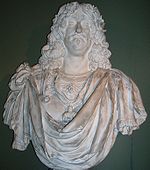
François Dieussart
Encyclopedia


Armentières
Armentières is a commune in the Nord department in the Nord-Pas-de-Calais region in northern France. It is part of the Urban Community of Lille Métropole, and lies on the Belgian border, northwest of the city of Lille, on the right bank of the river Lys....
, c. 1600 - London
London
London is the capital city of :England and the :United Kingdom, the largest metropolitan area in the United Kingdom, and the largest urban zone in the European Union by most measures. Located on the River Thames, London has been a major settlement for two millennia, its history going back to its...
, 1661) was a Flemish
Flemish people
The Flemings or Flemish are the Dutch-speaking inhabitants of Belgium, where they are mostly found in the northern region of Flanders. They are one of two principal cultural-linguistic groups in Belgium, the other being the French-speaking Walloons...
-Walloon
Walloons
Walloons are a French-speaking people who live in Belgium, principally in Wallonia. Walloons are a distinctive community within Belgium, important historical and anthropological criteria bind Walloons to the French people. More generally, the term also refers to the inhabitants of the Walloon...
sculptor who worked for court patrons
Noble court
The court of a monarch, or at some periods an important nobleman, is a term for the extended household and all those who regularly attended on the ruler or central figure...
in England and northern Europe, producing portrait busts in the Italianate manner.
He was likely an active sculptor by the time he arrived in Rome
Rome
Rome is the capital of Italy and the country's largest and most populated city and comune, with over 2.7 million residents in . The city is located in the central-western portion of the Italian Peninsula, on the Tiber River within the Lazio region of Italy.Rome's history spans two and a half...
in his early twenties. He appears in an entry from 1622 at the charitable organisation run at the Church of St. Julian of the Flemings and had become its director by 1630. He was invited to England by the Earl of Arundel
Thomas Howard, 21st Earl of Arundel
Thomas Howard, 21st Earl of Arundel KG, was a prominent English courtier during the reigns of King James I and King Charles I, but he made his name as a Grand Tourist and art collector rather than as a politician. When he died he possessed 700 paintings, along with large collections of sculpture,...
in 1636, and made a reputation there with the construction of a magnificent mechanical monstrance
Monstrance
A monstrance is the vessel used in the Roman Catholic, Old Catholic, and Anglican churches to display the consecrated Eucharistic host, during Eucharistic adoration or Benediction of the Blessed Sacrament. Created in the medieval period for the public display of relics, the monstrance today is...
forty feet (12.2 meters) high for Queen Henrietta Maria's chapel at Somerset House
Somerset House
Somerset House is a large building situated on the south side of the Strand in central London, England, overlooking the River Thames, just east of Waterloo Bridge. The central block of the Neoclassical building, the outstanding project of the architect Sir William Chambers, dates from 1776–96. It...
.
His bust of Charles I of England
Charles I of England
Charles I was King of England, King of Scotland, and King of Ireland from 27 March 1625 until his execution in 1649. Charles engaged in a struggle for power with the Parliament of England, attempting to obtain royal revenue whilst Parliament sought to curb his Royal prerogative which Charles...
, probably commissioned by Arundel, is at Arundel Castle
Arundel Castle
Arundel Castle in Arundel, West Sussex, England is a restored medieval castle. It was founded by Roger de Montgomery on Christmas Day 1067. Roger became the first to hold the earldom of Arundel by the graces of William the Conqueror...
, Another portrait bust of Charles I in Windsor Castle
Windsor Castle
Windsor Castle is a medieval castle and royal residence in Windsor in the English county of Berkshire, notable for its long association with the British royal family and its architecture. The original castle was built after the Norman invasion by William the Conqueror. Since the time of Henry I it...
, possibly by Thomas Adye or Francis Bird
Francis Bird
Francis Bird was one of the leading English sculptors of his time. He is mainly remembered for sculptures in Westminster Abbey and St Paul's Cathedral. He carved a tomb for the dramatist William Congreve in Westminster Abbey and sculptures of the apostles and evangelists on the exterior of St...
(c. 1737-44) is speculatively thought to be based on a now lost bust by Dieussart.
He is mentioned in a poem by Cornelis de Bie
Cornelis de Bie
Cornelis de Bie was a Brabant rederijker, poet, jurist and minor politician from Lier.He is the author of about 64 works, mostly comedies...
in his book Het Gulden Cabinet
Het Gulden Cabinet
The Golden Cabinet of the Noble Free Art of Painting, or Het Gulden Cabinet vande Edel Vry Schilder-Const, as it was originally known in Dutch, is a series of artist biographies and panegyrics with engraved portraits written by the 17th century notary and rederijker Cornelis de Bie...
as being court sculptor for the Stuarts in England. According to the RKD he learned his trade in Rome from François Duquesnoy
François Duquesnoy
François Duquesnoy was a Baroque sculptor in Rome. His more idealized representations are often contrasted with the emotional character of Bernini's works, while his style shows greater affinity to Algardi's sculptures....
.

